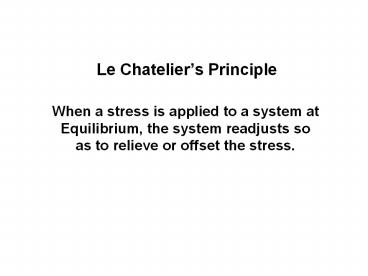Le Chatelier PowerPoint PPT Presentation
1 / 10
Title: Le Chatelier
1
Le Chateliers Principle
- When a stress is applied to a system at
Equilibrium, the system readjusts so as to
relieve or offset the stress.
2
What is meant by stress?
- Stress is any imposed factor which upsets the
balance in rates between the forward and reverse
reactions. - Stress factors may be
- changes in concentrations
- changes in total pressure (with gases only)
- volume changes (which cause the pressure
changes) - temperature changes.
3
Stress and Changes in Concentration
- Increasing the concentration of the reactants
will cause a stress which is relieved by an
increase in the concentration of product,
product. - If the product is increased, the reactants
will increase to offset the stress. - A 2B ? C D What happens if we increase D?
4
Stress and Changes in total Volume (or related
pressure)
- eg. N2(g) 3 H2(g) ltgt 2 NH3(g) 92.00
kJ - If we decrease the volume, we increase the
pressure. - This stress can be relieved if the system reduces
the number of molecules. - ie. 4 molecules ? 2 molecules
- The reaction shifts right.
5
- eg. N2(g) 3 H2(g) ltgt 2 NH3(g) 92.00
kJ - If we increase the volume, we decrease the
pressure. - This stress can be relieved if the system
increases the number of molecules. - ie. 4 molecules ? 2 molecules
- The reaction shifts left.
6
SUMMARY
- If an equilibrium contains gases,
- an increase in pressure, (decrease in volume),
will cause the equilibrium to shift to the side
with fewer molecules. - an decrease in pressure, (increase in volume),
will cause the equilibrium to shift to the side
with more molecules. - Note There is no shift in the equilibrium if
there are the same number of molecules on each
side of the arrows.
7
Stress and Changes in Temperature
- In any equilibrium reaction,
- a temperature increase favours the reaction that
absorbs heat. i.e. the endothermic reaction. - a temperature decrease favours the reaction that
produces heat. i.e. the exothermic reaction. - eg. N2(g) 3 H2(g) ltgt 2 NH3(g) 92.00 kJ
- The forward reaction is exothermic.
- The reverse reaction is endothermic.
- If we increase the temperature, the reaction will
shift left. - If we decrease the temperature, the reaction
will shift right.
8
Effect of a Adding a Catalyst
- A catalyst equally favours both the forward and
reverse reactions. Therefore a catalyst does not
shift the Equilibrium 's. It simply causes the
reaction system to reach Equilibrium in a shorter
period of time.
9
Example Problem
- 2 SO2(g) O2(g) ltgt 2 SO3(g) heat
- Indicate the favoured reaction either forward or
reverse under the stress applied below. - a) increase the SO2
- b) Partial pressure of SO3 is decreased (Some of
the SO3 is removed fro the system). - c) Decrease in temperature.
- d) A catalyst is added.
- e) He gas is added at constant volume so that the
total pressure is increased. - f) He gas is added, and the container is allowed
to expand so that the total pressure is kept
constant.
10
Problem
- heat 2 H2O(g) ltgt 2 H2(g) O2(g)
- Indicate the direction of the reaction most
favoured by each of the following conditions. - a) increase the H2
- b) the partial pressure of H2O is increased
- c) the O2 is increased
- d) increase the temperature
- e) decrease the volume of the container
- f) He gas is added

